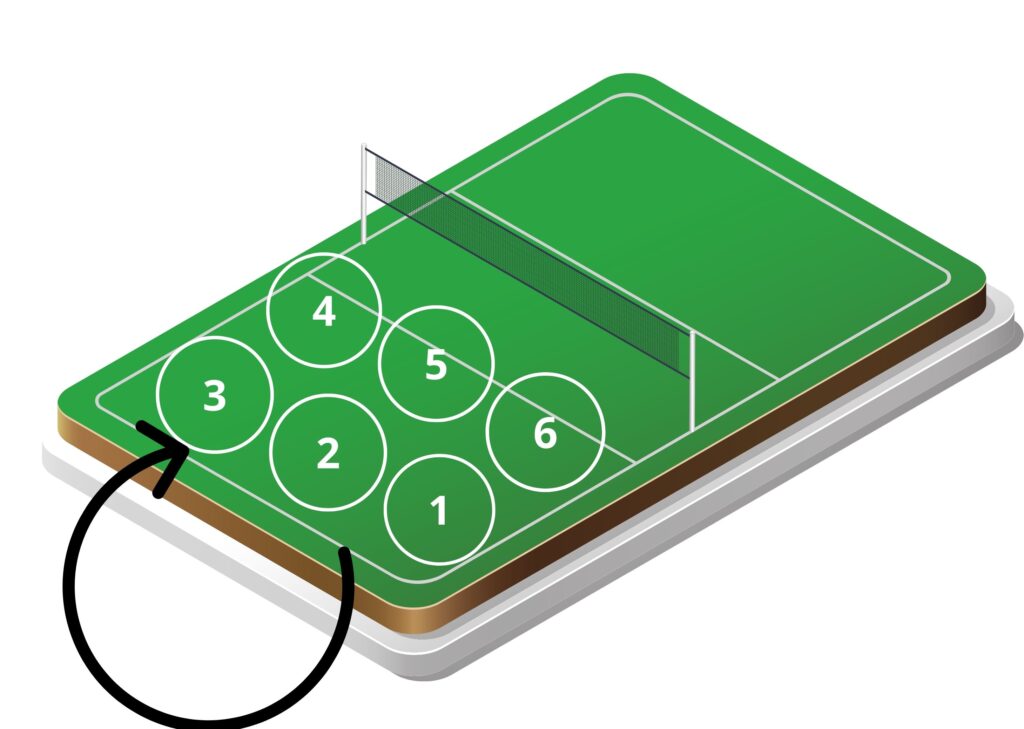There are 6 players on a volleyball court. They are standing in 2 rows: a row behind the net and a row after this. Players have to rotate over the court during the match. This makes the game more dynamic as players don’t stay in the same position during the whole match.

The 4-2 rotation is often used by newer players and teams. It is a type of attack during which the players take a certain position on the field. In a 4-2 rotation you have 2 setters (that provide assists) and 4 hitters (that score a point). The goal is to always have the setter as close to their front right position (just behind the net) on the court as possible. This limits your offense as the player on the front right is focused on giving an assist but makes everything more predictable.
Pros of this type of attack:
It is easier to implement than a 5-1 or a 6-2 rotation given that it is so predictable.
This type of attack removes a lot of decision-making as it is clear that the setter will move to the front right and the other players have to make sure that they move in the right location so that they are always in position. This allows the players to focus on their skills instead of having to think about the strategy.
You can still use the back row if the front row is not able to attack because there is another setter. There is a backup plan in case the setter receives the ball.
In this rotation you are also able to defend really well as the players with a defensive role are standing in the correct position already and don’t have to move around too much.
Cons of this type of attack:
This rotation can lead to attacks that are too predictable as players often send the ball in the same direction and it is known who is going to attack. It makes it easier for the setter to give an assist as this player is almost always in position. This is great for beginning setters as they don’t have to think a lot. The two attackers can switch positions to make the attack more unpredictable or the setter can drop the ball over the net to add some variation. Given the limited ways that you can attack, this type of rotation is mainly used by beginners.
Players have to follow the rotation over the field until the ball is served. Only once this is done, they can move over the field to their preferred position. As discussed, the setter always goes to the front right position. The other players have to adjust their positions based on this. In some instances, they have to run quite a lot over the field to go to their position.

Let’s take a look at what happens during each step of the 4-2 rotation:
Step 1: We have the two servers on the court (S), two middle players (M), and two outside hitters (O). The goal is that there is always one of each type of player on the front row and always one of each type of player on the back row. Players turn clockwise over the field when they score a point when the other team was serving. As you can see by the red S the goal of the 4-2 rotation is being fulfilled as there is a server on the right front side.
Step 2: All the players have to rotate one step in a clockwise direction. This leaves the setter in front on the left side. This is not the intended position of the 4-2 rotation and therefore the setter has to move to the right once the serve is over the net. The other two players in the front row have to adjust as well so that the server in front can take its position in the front row. The middle and outside hitter on the front row has to move up one position on the field. The players in the last row don’t move as this would make things too complicated. This is the most difficult step in a 4-2 rotation as all three players on the front row have to move.
Step 3: At this point, only the middle and the setter on the front row have to move to get the setter in the front right position. This makes it quite straightforward as these two players just have to communicate what they are going to do. The back row can just stand still.
Step 4: The next steps are just repeating everything we have seen before as the roles on the field are symmetrical. This means that the other setter is now standing in the desired front right position. The team doesn’t have to move as our goal of having a setter in the front right position is fulfilled. This shows the simplicity of the 4-2 rotation as players don’t have to move too often.
Step 5: We have to repeat step 2 again. This is the most difficult step as all three players on the front row have to move around. This can lead to some confusion but given that it only happens in the front row, it should be manageable, even for beginning teams. You can work on this during training so that everyone knows what is expected of them. You can always help out a player on your team if they are confused. This is done by showing where they have to go so you can clear up the confusion quite fast.
Step 6: This is a repeat of the third step. Only two players have to switch so it is quite straightforward what needs to happen. You once again want to have the setter in the front right position. This keeps everything predictable. It is the last step of the rotation and every player has taken up every position on the field. You start again at the first step and keep going through these steps during the match.
4-2 volleyball rotation with libero
The libero is a player that plays on the last row and can replace players at any point (without it counting as a substitution). They often replace middle blockers as these players are often taller and less agile. In a 4-2 rotation this is not an issue as we have two setters and the libero can focus on its main function of digging and diving. This means that the libero will often replace the middle blocker or outside player but (almost) never the setter in a 4-2 rotation. This always leaves two options open for a libero when they want to participate in the field during this type of rotation. This makes it quite easy for the libero to join the game.
In a 5-1 rotation there is only one setter and the libero often has to take up the role of a setter if the main setter is not able to do so. This limits the attack as the libero is limited in what they can do. The 5-1 rotation allows the libero to stand on the court more often as they don’t have to leave two setters on the court as one would in a 4-2 rotation.
We can therefore state that a 4-2 rotation is pretty good for a libero as it offers quite a lot of options to join the game and they don’t have to focus on setting as much as they would have to in other types of rotations. This makes it easier for the libero as they can exclusively focus on digging and diving and don’t have to think about setting too much.
Given that 4-2 is mainly played by newer teams, liberos don’t have a chance to play in this rotation that often. Most liberos will prefer a 5-1 rotation as it allows them more positions on the court and gives them more flexibility to join the game.
To conclude, we can state that the 4-2 rotation is mainly used by newer players. It is predictable what is going to happen: the setter (that will provide an assist) will move to the front right position and pass to the other two players that are standing on the front row. This predictability makes it easy for the team to know what they have to do. On the other hand, it also makes it easier for the other team to predict what you are going to do. This is why more advanced teams often use 5-1 or 6-2 rotations as these are more complex and can make it harder to defend.
